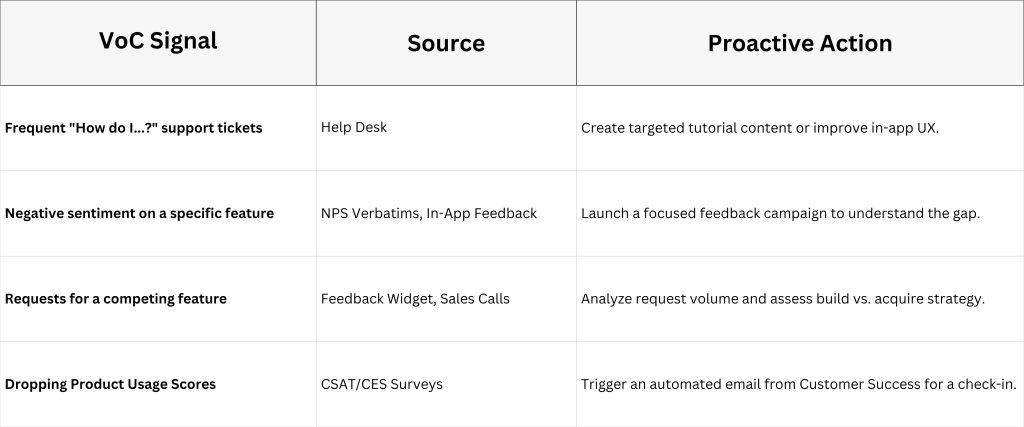
In the unforgiving world of Software-as-a-Service (SaaS), your growth is a delicate balancing act. You’re constantly acquiring new users while fighting to retain existing ones. Customer churn is the silent killer of SaaS dreams, and a stagnant product roadmap is a one-way ticket to irrelevance. What if the key to solving both challenges has been whispering to you all along? It has. That key is the Voice of the Customer (VoC).
For SaaS companies, customer feedback isn’t just a nice-to-have metric; it’s the fundamental pulse of your business. It’s the raw, unfiltered data that tells you why customers stay, why they leave, and what they desperately need you to build next. This article will guide you through transforming passive feedback into an active strategy that systematically reduces churn and fuels a customer-centric product roadmap.
Understanding the Stakes: Why VoC is Non-Negotiable for SaaS
Unlike traditional businesses, SaaS operates on a subscription model where customer loyalty is recaptured every billing cycle. Consequently, understanding customer sentiment is not a periodic exercise but a continuous necessity.
A robust VoC program does two things simultaneously:
- It acts as an early-warning system for at-risk customers, allowing you to intervene before they churn.
- It serves as a strategic compass for your product team, ensuring you build features that drive expansion and retention.
Ignoring VoC means flying blind. You might see churn spike, but without the “why,” you’re left guessing- throwing precious resources at solutions that don’t address the root cause.
The Direct Link: Using VoC to Diagnose and Reduce Churn
Churn is rarely a sudden decision. It’s the culmination of unmet expectations, unresolved frustrations, and perceived lack of value. A VoC platform like Odio helps you decode this journey.
1. Identify the “Why” Behind the Goodbye
When a customer cancels, the stated reason is often superficial (“I found a cheaper alternative”). The real reason is usually buried deeper. By integrating VoC at key moments, you can uncover the truth:
- Exit-Intent Surveys: Deploy a short survey when a user navigates to the cancellation page. Ask: “What is the primary reason for leaving?” and “What could we have done better?”
- CRM & Support Integration: Tag support tickets with themes from customer feedback (e.g., “feature missing,” “bug frustration,” “UI confusing”). This creates a quantitative dataset from qualitative pain points.

Table: Common VoC Churn Signals & Proactive Actions
2. Close the Loop with At-Risk Customers
Collecting feedback is only half the battle; acting on it is what builds loyalty. When a customer reports a low Net Promoter Score (NPS) or a low Customer Satisfaction (CSAT) score, this should trigger an immediate workflow in Odio.
- Automate Alerts: Notify the Customer Success team when a negative score is recorded.
- Personalize Outreach: Empower your team to reach out personally. A simple, “We saw your feedback about [issue]. We’re sorry to hear that and are working on it. Here’s what we can do for you now…” can transform a detractor into a promoter.
Fueling Your Engine: Using VoC to Drive Your Product Roadmap
Your product roadmap should be a reflection of your customers’ collective needs and your business’s strategic vision. VoC provides the empirical evidence to balance this equation.
1. From Feature Requests to Strategic Themes
Stop counting feature requests. Instead, use Odio’s text analytics to categorize them. You’ll often find that 100 different feature requests are actually variations of 3-4 core customer needs or “jobs to be done.”
- Theme Analysis: Group feedback into themes like “Improve Reporting,” “Enhance Collaboration,” or “Streamline Onboarding.”
- Prioritization Matrix: Plot these themes on a chart based on Customer Impact (how many users requested it) vs. Strategic Value (how well it aligns with your vision).
This moves your roadmap from a “who shouts loudest” list to a strategic, data-driven plan. For more on this, explore our guide on building a data-driven product strategy.
2. Validate Ideas Before You Build
Before dedicating engineering resources to a new feature, use your VoC channels to test the waters.
- Create a “Feature Idea” Portal: Allow users to submit and vote on ideas. This not only generates great ideas but also validates demand.
- Targeted Surveys: Send a survey to a segment of power users: “How valuable would a [proposed feature] be to your workflow?” This quantitative data de-risks your development investments.
Implementing a Winning VoC Strategy with Odio
To master this, you need a system, not just a collection of tools. A dedicated customer experience platform is essential.
- Integrate Everywhere: Embed feedback collection (NPS, CSAT, CES) at key touchpoints: post-support, during onboarding, and within the product itself.
- Centralize the Data: Pull all feedback from surveys, support tickets, sales calls, and social media into a single platform like Odio to break down data silos.
- Analyze and Act: Use AI-powered analytics to detect sentiment and emerging trends automatically. Then, create automated workflows to ensure the right insights reach the right teams (Product, Marketing, Success) at the right time.
Conclusion: Stop Guessing, Start Knowing
In the data-driven landscape of SaaS, hope is not a strategy. By building a mature VoC program with Odio, you replace guesswork with insight. You can proactively defend against churn by understanding customer pain points and confidently build a product roadmap packed with features your users truly want and need.
The future belongs to SaaS companies that listen systematically and act decisively. Are you ready to let your customers guide you to growth?
Ready to Transform Your Customer Feedback into Growth?
Your customers are telling you exactly how to grow your business. The only question is – are you listening effectively?
Don’t let another valuable insight slip through the cracks.
See Odio in Action – Watch a 5-minute personalized demo and discover how we help SaaS companies like yours:
- Reduce churn by up to 30%
- Prioritize product features with 90% more accuracy
- Turn customer complaints into expansion opportunities

